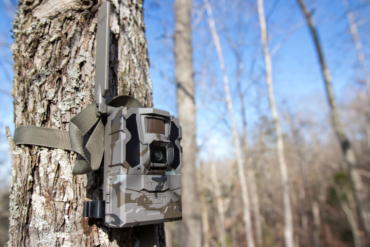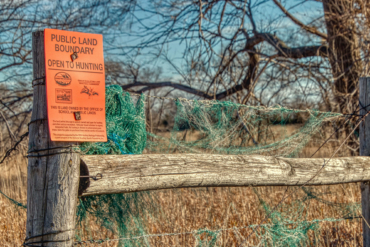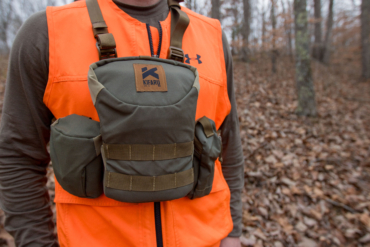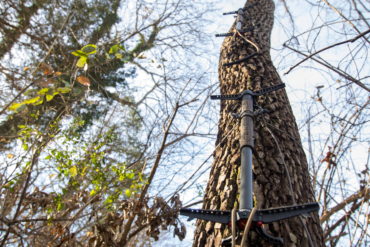Whether you’re birding, wildlife watching, or hunting, binoculars can be extremely helpful for seeing things up close. But because of all the features, buying your first pair of binoculars can be confusing.
Binoculars have different sizes, magnification powers, and prices. The best way to find the right pair of binoculars is to test out a few different types in person to see how they fit your face and how clear of an image you need.
Before you go, or if you can’t get into a shop to try different pairs, there are a few specs you’ll want to keep in mind. Here are the main features to consider for choosing your binoculars.
Magnification Power
Magnification power is one of the numbers to look at when considering which binoculars to buy because it establishes how far you’ll be able to see. It’ll also be the first number in the model name.
In general, you’ll likely be choosing between a magnification of eight or 10, meaning an object will appear eight or 10 times closer than the naked eye. While you’ll be able to see objects closer with 10 magnification, it also magnifies your movements and won’t give you as wide of a field of view.
If you’re hiking or on a moving platform or vehicle, an eight-power magnification will likely be your best bet because it’s easier to keep steady.
If you’re using it for stargazing or reading numbers far away, it might be better to go for a higher magnification number. With this option, a tripod can be useful to keep it steady.
Objective Lens Size
The objective lens size generally tells you the overall size of the binoculars (it’s also the second number in the model name). On the binoculars, the objective lens is the part closest to what you’re viewing.
The lens size number is the diameter of the lens in millimeters. Along with describing the general size of the binoculars, the objective lens number also gives you an idea regarding the image’s brightness and overall field of view.
The larger objective lenses will often allow for a brighter image — because it takes in more light — along with a wider view. However, these larger lenses are often heavier and larger. If you plan to use your binoculars for hiking, backpacking, or traveling, a compact pair (less than 30 mm) might be the best choice for you.

Field & Angle of View
The field of view (FOV) denotes the width of the area you can see at a certain distance. Normally, that’s a measurement in feet or meters measured at 1,000 yards or meters from where you stand.
The angle of view (AOV) is the angle between the two sides of your vision. The higher the AOV, the wider the FOV will be. The benefit for AOV is it doesn’t require a specific distance.
Both the FOV and AOV are useful factors to compare two similar binoculars because they can occasionally differ dramatically, even when all other specifications are the same.
Having a wider FOV is useful when you want to scan over a large area like when you’re whale or bird watching.
Eye Relief
If you wear glasses, take note of the eye relief. This denotes the distance between the eyepiece and your eyes where you’ll still see the whole FOV.
Most binoculars have adjustable eyepieces so you can make the eye relief value smaller, but it will only go out to the specified distance.
For glasses wearers, look for eye relief of at least 11 mm.

Protective Features
If you plan on never actually using binoculars and just always keeping them safely tucked away, then protective features might not be that important. Otherwise, consider how much protection your binoculars will need.
For water watchers or rainy hikers, consider getting a pair with waterproof or weather-resistant features. If going from warm to cold environments or especially humid areas, think about fog-proof binoculars.
And if you’re generally clumsy like me or plan to keep the binoculars in a backpack, make sure your binocs include rubber coating.
Waterproofing & Weather Resistance
Waterproofing for binoculars is a little different from, say, waterproofing a jacket. Waterproof binoculars typically have an O-seal to keep out most moisture, but they aren’t like an underwater camera. They’ll live through a quick deluge or splash, but they aren’t ready for full swimming lessons.
Weather-resistant binoculars have even less water protection. But if you just want some insurance in case of a surprise shower, it may be all that’s necessary.
Fog-Proofing
In non-fog-proof binoculars, the inside and outside lenses can get foggy when transitioning from cold to warm environments (think a cold hike to a warm car or air conditioning to New York summertime).
With fog-proof binoculars, the manufacturer has replaced the air inside with a dry gas, which doesn’t have any water content and therefore won’t condense. These binoculars are fully sealed to keep the gas in and humidity out, so they’ll also likely be waterproof.
Rubber Coating
For any sort of outdoor adventuring, a rubber coating around your binocs tends to be a worthwhile feature. The coating isn’t like a LifeProof phone case, but it’ll keep your investment safe from small bumps.
For some extra safety, you may want to also consider getting a binocular case for when you aren’t using them.

For more specific binocular recommendations, check out some of our previous reviews, like the Pentax VD 4X20 WP, Nikon Aculon T02, or Vortex Optics Diamondback 15×56.
Your best bet is to find the features that meet your needs, try some out, and then invest. Enjoy!









